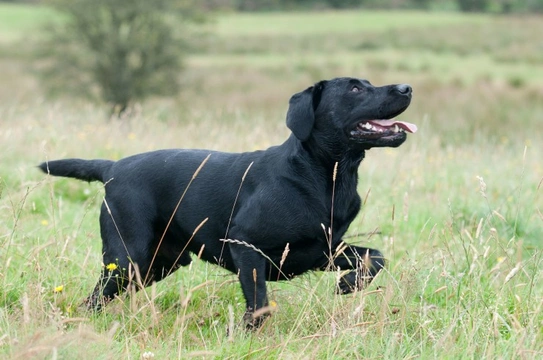
Show Lab vs. Working Labrador: Key Differences
The Labrador Retriever or ‘Lab’, including black labs, yellow labs, chocolate labs, etc. is a breed of ‘working dog’ or ‘sporting dog’ that is popular all over the world. Popular enough, it seems, that the American Kennel Club and the UK Kennel Club have slightly different standards. Most labs, of course, qualify by both measures. The only times the differences are relevant is for show dogs.
They are also prized as guide dogs, police dogs and search & rescue dogs. They are considered ‘America’s most popular breed’, and beloved family pets even if they don’t ‘have a job’ or a pet show career.
In this article, we’ll explore what makes a lab a lab, talk about the differences between those used in sport – as actual retrievers – and those whose primary duties involve competing for ‘best in breed’.
Characteristics and personality
Though some writers suggest that different types of labs (black, yellow, etc.) have a tendency towards different personalities, there is little real evidence of that. Overall, labs of all coat types tend to be friendly, affectionate and easily excitable. They are healthiest when they can be very active, and they love spending time with humans.
The breed has a reputation for being very good with even small children, and of being quite protective of their ‘tiny humans’. They are considered very easy to train.
The one ‘drawback’ when it comes to training labs is probably the factor that makes them so endearing – they remain extremely playful, energetic and ‘puppy-like’ well into their adulthood. So long as you are prepared to let them burn off all that energy productively (or at least non-destructively), you’re likely to see this as an asset rather than a flaw.
Just one more trait that labs have – they tend to have voracious appetites, so don’t leave tasty morsels around the house – they will disappear rapidly with only one culprit! If you purchase a lab with the intent of using them as a ‘retriever’ of game, you need to instil in them from early days that not all food is for them.
About that ‘excess energy’…
Labs are big, energetic and – let’s be honest – a bit clumsy. They need a great deal of space to run around in and make poor ‘indoor dogs’. Even a large house won’t have the space they need to charge about in safely. You’ll need a substantial garden, at the very least.
Now, this can be good for you. They need to exercise literally every day, and this can help keep you active too. They can become destructive if they get bored or are cooped up in the house all day. In fact, some will chew up anything they can get their teeth around. This isn’t malicious on their part. They are merely curious, energetic and interact with the world primarily through their teeth.
So, DO let them run along beside you on daily jogs, bike rides, etc. DO take away the kid’s phones until they go play in the yard with the dog for an hour after supper. DO NOT leave them in a small apartment unattended while you go to work.
If you have a swimming pool and a lab, the lab will spend a lot of time in the water. Even when it is shockingly cold outside. Be warned.
So why was the Labrador breed developed?
The Labrador retriever is a type of working dog. It is called a ‘gundog’ in the UK and a ‘sporting dog’ in the US because they are bred to be excellent retrievers. A typical gundog is a hunting companion, capable of being trained to chase after wild game that has been shot – especially ducks and water birds – and swim out to where they have fallen and bring them successfully back to the hunter. Naturally, they need a calm disposition so as not to be ‘spooked’ by the report of the shotgun. They also need to be excellent swimmers.
However, this is not the origin of the breed. They come from Newfoundland, not Labrador, and were originally bred to ‘retrieve’ injured fish who had shaken free of their hooks and to help pull in fishing nets. This is the reason they were endowed with excellent swimming skills, water-shedding coats and a general resistance to cold, wet conditions. They were originally referred to as the St John’s Water Dog.
They were brought to England in the early 1800s and were revered as gundogs as early as 1830. The tag ‘Labrador’ apparently came from a misunderstanding by an early English enthusiast as to their actual origin.
Labradors were recognised (as ‘Labradors, at least partially because there was already a popular breed of dog called the Newfoundland) by the UK Kennel Club in 1903, and by the AKC in 1917.
Today, labs are bred both as gundogs and as show dogs, in the UK and in the US. Though there are slight differences between these two types there are also many similarities, and many individuals could be classed as either or both types.
What makes a Labrador either a ‘gundog’ or a ‘show dog?
Technically, there is only one ‘breed’ of Labrador retriever. There can be quite a bit of variation within that breed, but most of it will fall within a very narrow band near the established ‘show’ or ‘field’ standards.
Working dogs – like gundogs – don’t have to ‘toe the line’ as closely as show dogs, and many dogs with pedigrees longer than some European royalty are ‘not fit for showing’ due to being too large, too slim, or having the wrong muzzle shape or the wrong coat pattern. These dogs are perfectly well suited to the original purpose of the breed, and so make excellent gundogs.
As so called ‘field trials’ began to become popular alternative to the more genteel dog shows, these ‘filed bred’ labs – ‘proper gun dogs’ you might say – began to be bred to a slightly different standard than the KC’s standard for show dogs.
As a result, there is a difference in the physiques of labs bred for sport. They tend to be slimmer than the show dogs, be longer in the leg, and to have longer muzzles.
By comparison, the show type dogs are heavier, but shorter in the leg than the field types. They are typically (but not always) poorer jumpers as a result and have a reputation for being a bit clumsier.
None of that really make them ‘better’ or ‘worse’ retrievers. They simply qualify or disqualify the dogs from winning dog shows. That means the puppies of ‘field’ type labs might be dramatically less expensive than those of winning show dogs, and much easier for sporting owners to acquire.
As proof, look at whether winning show dogs are ever used as gundogs. Indeed, they are. Some breeders even specialise in ‘dual purpose’ Labradors who are equally at home on stage as they are in the reeds.
These differences have been the same all over the world, and especially in America. There, the two types are called the ‘English type’ (show dogs) and the ‘American type’ (working dogs).
Is there a personality difference between gundogs and show dogs?
Some breeders and owners have noted that actual working dogs tend to have a much more energetic, less disciplined temperament. They are also said to be much easier to train, and often to be more sensitive or loving of their owners. Some note that this extra sensitivity leads to nervousness, but this has never been a common trait in either ‘type’ of the breed. They are bred to remain calm in a shooting situation, after all.
Field type labs are said to have a much stronger hunting instinct, and this can make them more of a handful to look after – they may be more likely to chase wild animals when out on a walk, for example. As this breed is highly energetic and requires a lot of attention as a default, this is something you should consider carefully.
By comparison, the show type dogs are said to be calmer of demeanour, and to grow out of the very active, excitable ‘puppy’ stage at a much younger age than gundog labs.
Where to find pure bred lab pups
Due to being the UKs most popular Pet Classifieds website, Pets4Homes has the most extensive list of labradors for sale, both KC registered and non KC regsisteredfrom both private individuals and hobby breeders .
The UK Kennel Club actively maintains a list of approved breeders here.
There are also many options for adopting rescue dogs all over the world including our labrador adoption page on Pets4Homes.
So, there you have it.
Labs, whether black, yellow or chocolate, gundog or show dog, are friendly, energetic and very loving animals which make great companions for just about anyone. They are especially suitable for people who are active outdoors and have the time to devote to making they and their dogs both get a healthy amount of exercise.
As pure-bred dogs go, they are a very hearty breed, and not anywhere near as prone to genetic disorders as some breeds. Those few congenital defects which are associated with labs are generally well understood, and you can typically asses their risk before buying.
Most owners will have a strong preference for either the ‘show’ or ‘field’ type of labs, but unless they are actual hunters or show enthusiasts the preference usually comes down to personality, and this is highly variable. Both types are very close in attributes, it all depends if you are looking for a show dog, a hunting dog or a family pet and nothing else.



